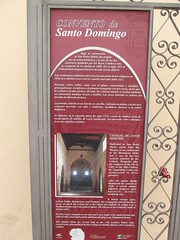Convento de Santo Domingo
Commemorated on 1 plaque
Convento de Santo Domingo Bajo la advocacion de San Pedro Martir, fue erigido por la orden dominica, y es uno de los dos conventos fundados por los Reyes Catolicos tras la conquista de la ciudad en 1485. En el siglo XVI el Tribunal de la Inquisicion tuvo su sede en este edificio. Tras el abandono definitivo del convento por parte de los religiosos en 1836, tuvo distintos unos (carcel, cuartel, mercado, taller, etc.). Presenta varios estilos, como son el gotico, renacentista y mudejar, principalmente. La iglesia es de planta rectangular con tres naves, de las que la central es la mas ancha y elevada. Su cubierta interior se realiza mediante un artesonado mudejar de par y nudillo. Las naves laterales se cubren con bovedas de diferente factura. La portada, situada en un lateral, es sencilla, realizada en piedra, con un arco carpanel decorado con alfiz y emblemas heraldicos alusivos a la orden dominica. El claustro, de la segunda mitad del siglo XVII, consta de amplios arcos de medio punto de ladrillo de rosca moldurada, descansando sobre columnas lisas con capiteles corintios.
English translation: Convent of Santo Domingo Under the patronage of San Pedro Martir, was built by the Dominicans order, and is one of the two convents founded by the Catholic Kings after the conquest of the city in 1485. In the sixteenth century the Court of the Inquisition was based in this building. After permanent abandonment of the convent by the Religious in 1836, had a different (prison, barracks, market, shop, etc..). Presents various styles, such as Gothic, Renaissance and Mudejar, mainly. The church is rectangular with three naves, of which the center is wider and higher. Your inner cover is made using a Mudejar coffered pair and knuckle. The aisles are covered with vaults of different bill. The home, located on a side, is simple, made of stone with a rectangular frame centered arch decorated with heraldic emblems and alluding to dominica order. The cloister of the second half of the seventeenth century, consists of broad arches of brick molded thread, resting on plain columns with Corinthian capitals.
Convento de San Domingo - Calle Arminan, Ronda, Spain where it built (1484)

